| Srl | Item |
| 1 |
ID:
113528
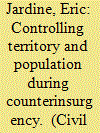

|
|
|
|
|
| Publication |
2012.
|
| Summary/Abstract |
Much of the literature on counterinsurgency focuses on the development of indigenous security capacity as the best policy for a state to achieve functional control over its people and territory, and, by extension, victory over an insurgency. This understanding serves as a guiding principle in Afghanistan. The policy erroneously maintains that a state's ability to exercise functional control over its territory is an almost exclusive product of state security capacity. In this article, I argue that the scope of a state's control over its national territory is more properly conceptualized as a function of both the state's aggregate security capacity and the costs of projecting power over distance. Functional territorial control, therefore, can be best maximized when the return on investment in security capacity is equal to the return on investment in factors that reduce the costs of power projection.
|
|
|
|
|
|
|
|
|
|
|
|
|
|
|
|
| 2 |
ID:
121896
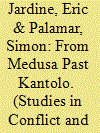

|
|
|
|
|
| Publication |
2013.
|
| Summary/Abstract |
Canada's counterinsurgency in Kandahar province, Afghanistan, involved two distinct operational strategies: an initial enemy-centric strategy and, after 2009, a population-centric strategy. Using insurgent-initiated attacks against civilians as a measure for the level of control and security provided by the counterinsurgency, this article tests the effectiveness of these two strategies using a quasi-experimental research design. This article finds that a population-centric counterinsurgency strategy that aimed to provide security to the population rather than destroy the insurgency resulted in the most controlled and secure environment for the civilian population. To the extent that a secure civilian population is important for successful counterinsurgency, the post-2009 population-centric operational strategy of the Canadian Forces, International Security Assistance Force (ISAF), and the United States increased the chances of a successful counterinsurgency in Afghanistan.
|
|
|
|
|
|
|
|
|
|
|
|
|
|
|
|
| 3 |
ID:
110080
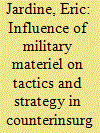

|
|
|
|
|
| Publication |
2011.
|
| Summary/Abstract |
This paper presents an analysis of the multiple effects of greater military materiel and troop quantities on the conduct of counterinsurgency. Although counterinsurgency is often considered a manpower intensive form of warfare, this paper posits that several dangers are inherent in the provision of more troops to the waging of such campaigns. Using the British counterinsurgency in Malaya as an illustrative, inductive case study, this article argues that greater materiel strength distorts the counterinsurgency's tactical and operational efforts, which can then dislocate their strategic plans.
|
|
|
|
|
|
|
|
|
|
|
|
|
|
|
|
| 4 |
ID:
104272
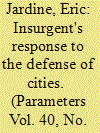

|
|
|
| 5 |
ID:
111891
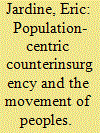

|
|
|
|
|
| Publication |
2012.
|
| Summary/Abstract |
The theory of population-centric counterinsurgency rests upon the untenable premise that the population within a theater of operations is fixed in place. By showing that people tend to move away from contested rural areas towards the relative safety and prosperity of counterinsurgent-controlled areas, this article demonstrates that this crucial premise is empirically false. Furthermore, a theory of counterinsurgent resource deployment, population movement, and incumbent strategic ineffectiveness is presented. Ultimately, the application of counterinsurgency resources actually dislocates the population from their place of residence and causes them to move into cities. When the urban areas' ability to absorb newcomers is overwhelmed, localized negative externalities emerge and can give rise to crime and insecurity. Such increased insecurity then creates an incentive for the counterinsurgency to retrench its resource use into the cities. As more physical territory is conceded to the insurgency, the relative strategic effectiveness of the counterinsurgency declines.
|
|
|
|
|
|
|
|
|
|
|
|
|
|
|
|
| 6 |
ID:
114961
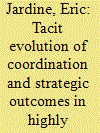

|
|
|
|
|
| Publication |
2012.
|
| Summary/Abstract |
Highly fragmented insurgencies often lack explicit coordination mechanisms such as plans, direct means of communication, or hierarchical organization. Many such insurgencies nevertheless obtain a high degree of coordination that produces strategic-level effects. This article presents a theory of how coordination can emerge tacitly in highly fragmented insurgencies, and how this can produce strategic-level effects. Strategic effects emerge through a combination of complementary and supplementary tactical-level actions between commonly positioned insurgent groups. The theory is then tested again evidence from the Soviet-Afghan War. The evidence presented shows that some of the Mujahidin's strategic-level effectiveness was produced through tacit coordination.
|
|
|
|
|
|
|
|
|
|
|
|
|
|
|
|
| 7 |
ID:
163801
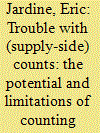

|
|
|
|
|
| Summary/Abstract |
Many national security threats now originate on the Dark Web. As a result of the anonymity of these networks, researchers and policymakers often use supply-side data (i.e. the number of sites) as a threat metric. However, the utility of these data depends upon the underlying distribution of users. Users could be distributed uniformly, normally or in a power law across Dark Web content. The utility of supply-side counts varies predictably based upon the underlying distribution of users. Yet, the likelihood of each distribution type varies inversely with its utility: uniform distributions are most useful for intelligence purposes but least likely and power law distributions are least useful but occur most commonly. Complementing supply-side counts with demand-side measures can improve Dark Web threat analysis, thereby helping to combat terrorism, criminality and cyberattacks.
|
|
|
|
|
|
|
|
|
|
|
|
|
|
|
|